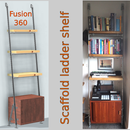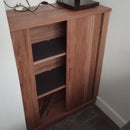Introduction: Electric Upright Bass
I used to have an electric upright bass many years ago but sold it as I only used it on and off. The amount it cost and the amount I played it didn't match....once sold i bought a synthesizer and a family holiday. Every now again I miss playing a double bass style instrument so decided to make one as this would keep the cost down quite a lot. In the end I think I spent around £120 mainly on strings, machine heads, pickups and timber for the body. It sounds fairly good and i am pleased with the result, especially considering that it is the first instrument I've made.
I have added a CAD file to this instructable which has some rough dimensions on it and I used it to scale off anything I wanted at the time. It is far from a complete drawing but I've included it for reference as it may be useful to some one. Most of the dimensions I used were either off the internet or this drawing.
Materials
A selection of timber - I used beech and oak for the neck, beech for the fingerboard and bridge and lime for the body. All of the oak and beech I already had from previous projects and the lime cost me £60 off ebay (I only used half though)
Strings - I bought some super cheap ones off amazon for £14 Double bass strings
Machine heads - I got these off ebay for £16 Machine heads
Pickups - I bought a second hand set from ebay for £23 (look like Fishman BP 100 but wasn't specified on listing)
Machine screws and threaded insert nuts - I had some already
M12 Threaded rod - £2.50 for 1m from Toolstation
Silicon sealant and cornflour to make 'oogoo'- I had some part used already
Plywood or MDF to make a fingerboard radiusing jig.
Tools
Table saw
Router
Drill press and bits
Planes
Chisels
Sander and sandpaper
I have entered this instructable in to the wood competition. If you have found it interesting or informative please vote!!
Step 1: Neck
As the neck is fairly wide, to accommodate the fingerboard, I decided to make it from three planks of timber glued together. I used two bits of beech on the outside and a piece of oak in the middle which would give a nice look to the back of the neck when it is finished.
I first cut the timber to a rough size and put them through my planner/thicknesser to get them flat and uniform. Once they were planned I cut them to to size making sure that I used the dimension of the bottom of the neck. I then drew the profile of the neck on to one of the beech parts and cut it with a combination of a table saw and jigsaw. I then finished the shaping with a bit of sanding with an oscillating bobbin sander and dremel for the curves and a belt sander.
Once I was happy with the shape I roughly cut the others to the same size with a jigsaw and then used flush trim bit to make them all exactly the same, attaching the pieces together with double sided tape.
I then glued the three bits together and clamped with as many clamps as I had.
Step 2: Fingerboard
For the fingerboard I used beech as I had quite a bit of beech knocking around. I'm sure there are better woods to make fingerboards out of but for this project any hardwood would have been acceptable.
There are a couple ways that a fingerboard can be shaped, by hand or with a router and a jig. I went for the lazy route so chose the latter. First I put the timber through the planer thicknesser to get everything to the correct size. Next I needed to cut the plank of wood at an angle which can be tricky with a table saw. To cut the angle I fixed some pieces of old laminate floor along the edge of the timber at the angle I required. I could then use the laminate floor as a reference up against the fence and cut the angle safely.
To radius the top of the fingerboard I made a jig which would pivot the fingerboard while a router was moved along the top, with a straight cut router bit, to cut a curve on the top of the board. I have added a lot of photos here as it is quite difficult to explain. I used nut inserts to make the pivot points and a drill bit to use as a lever to move the jig.
After I had finished the full length of the fingerboard I realised that I needed to raise one end of the fingerboard to get the vertical edges of the fingerboard the same height all the way down due to the board being tapered. I raised the narrow end of the board with some washers and re-cut the board. One I was happy I cut the board to length and hand sanded it to a fine finish. I went up to 400 grit.
Step 3: Finishing the Neck and Fingerboard
As the fingerboard has now been cut the neck needs to be cut to the same taper. I started by drawing the outline of the board on the neck and nail gunned some laminate floor offcuts along the edges and cut with a flush trim router bit. As the bit didn't cut the full depth of the neck I had to finish some of the neck off with a hand plane.
Next I created a cavity in the top of the neck for the machine heads. I determined the size hole I needed and cut three holes with a pillar drill and fostner bits. I then finished the holes with a chisel and sanded the inside with a bobbin sander. I then shaped the rest of the head with a combination of chiseling and sanding. I then made a nut for the end of the fingerboard and made some slots for the strings with a small round file. I then oiled the neck and fingerboard. I used a coloured oil for the fingerboard as I wanted it to be a slightly different colour to the rest of the neck.
Once everything was dry I glued and clamped the fingerboard to the neck protecting the fingerboard from the clamps with anything I could find! Mainly MDF and socks.
Step 4: Body
For the main body I used some lime wood I saw on eBay. One side was waney edged so I wanted to incorporate this edge in to the body design. I firstly figured out where I wanted the neck to be and to visualise the finished body I cut a piece of paper to the profile similar to the waney edge to I could more easily see the finished shape. Once I was happy I cut the plank to size and the profile with a jigsaw.
Now I had the body I needed to cut a recess in the top of it to house the neck with a router and a chisel. I then put three nut inserts in to the back of the neck and three corresponding holes in the back of the body so I could screw the two parts together.
I did add some machine heads at this time but I had to replace these later on as the holes in the heads weren't wide enough for the E string to fit through.
Step 5: Tailpiece No. 1 and No. 2
I then made a tailpiece which was just a block of shaped timber which would be screwed on to the body with threaded inserts. My first attempt was quite small and was only held on with two bolts to the upper end of the block. After I put the strings on I noticed that the tailpiece was lifting and the angle of the strings didn't seem quite right. I therefore abandoned that one a made a taller one and bolted it on to the body with two bolts to the back and two to the front. This worked much better!
Step 6: Bridge and Tail Spike
On ebay I found an auction for a pick up but it came with a bridge - but the bridge was broken. I wasn't too fussed about this though as I mainly wanted the pick up.
The bridge I made was made of beech again which I cut to a shallower height than the 'real' bass bridge as I wanted to put this bridge on a block. Doing this if the height of the bridge needed to be adjusted I could make a simple block rather than a new bridge. I had seen a few bridges on the internet and I went for a modern baffled bridge. To make the bridge I first cut the main shape out and marked where I wanted to put the holes. After drilling them all I sanded one side at 90 degrees to the feet and the other side at an angle (not sure what angle - it just looked right).
I then needed to make tail spike. I knew that threaded rod was quite cheap so I devised a simple way of using that rather than a more expensive bought solution. I drilled a hole approx. 200mm (8") deep in to the body in to which would go the threaded bar, using a washer and nut as a stop to maintain the correct height and a screw that would go through another insert and push the rod to hold it in place. To create an easily screwable bolt I soldered a butterfly nut to the end of a machine bolt.
Step 7: Finished
Now it was all finished I oiled all the parts that needed oiling and put on some new machine heads that were capable of holding the E string and put on my pickup I got second had from eBay.
I then plugged it in and had a go - and I must say I was really rather pleased.
I do have an issue though where the E string buzzes when I fret near the nut, not quite figured that bit out yet so have yet to sort it. The pick up works really well but maybe a little sensitive but I guess I can adjust some amp settings or move the pick up a little.
EDIT
I have added a very simple wav. of the bass so you get a basic idea of the sound. It was recorded just straight though the computer with no additional amps or effects. You can hear the sensitivity of the pickups as my hands move up and down the strings.
I do know someone who plays double bass that I see very occasionally, If he comes round and I get the chance to record him I will add a more impressive sample! Just need a ton of practice now.
Attachments

Third Prize in the
Maker Olympics Contest 2016

Runner Up in the
Wood Contest 2016












